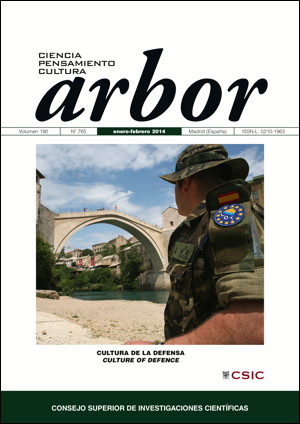Modernisation of the Armed Forces
DOI:
https://doi.org/10.3989/arbor.2014.765n1005Keywords:
Spain, Army, Armed Forces, Modernisation, General Gutiérrez Mellado, KingAbstract
This article briefly reviews the recent history of the Spanish Armed Forces, stressing the importance of the military institution and its role in contemporary Spanish history. Following Franco’s death there was an attempt to bring the command of the Armed Forces under democratic control within the constitution, a process in which General Gutiérrez Mellado played a crucial role. Since 1981, two important measures have been taken in the military sphere: “case 2/81”, prosecuting the perpetrators of the attempted coup in 1981, and Spain’s application to join the Atlantic Alliance (NATO), a very important step in shaping the country’s future and driving the modernisation of the Spanish Armed Forces, putting them on an equal footing with their peers elsewhere in the Western world. After the socialist victory in 1982, the PSOE government changed direction, skilfully transforming its initial anti-Americanism, obtaining Spain’s membership of NATO following the 1986 referendum, and profoundly changing the Armed Forces, thus eliminating military tensions. The last stage of the modernisation process was led by Aznar’s government, with the professionalisation of the Armed Forces and the integration of Spain in NATO’s military structure.
Downloads
References
Seco Serrano, C. (1984). Militarismo y civilismo en la España Contemporánea. Madrid: Instituto de Estudios Económicos.
Ley Orgánica 6/1980, de 1 de julio, por la que se regulan los Criterios Básicos de la Defensa. Nacional y la Organización Militar.
Ley 85/1978, de 28 de diciembre, de Reales Ordenanzas para las Fuerzas Armadas. (Vigente hasta el 1 de octubre de 2011).
Published
How to Cite
Issue
Section
License
Copyright (c) 2014 Consejo Superior de Investigaciones Científicas (CSIC)

This work is licensed under a Creative Commons Attribution 4.0 International License.
© CSIC. Manuscripts published in both the printed and online versions of this Journal are the property of Consejo Superior de Investigaciones Científicas, and quoting this source is a requirement for any partial or full reproduction.
All contents of this electronic edition, except where otherwise noted, are distributed under a “Creative Commons Attribution 4.0 International” (CC BY 4.0) License. You may read the basic information and the legal text of the license. The indication of the CC BY 4.0 License must be expressly stated in this way when necessary.
Self-archiving in repositories, personal webpages or similar, of any version other than the published by the Editor, is not allowed.














